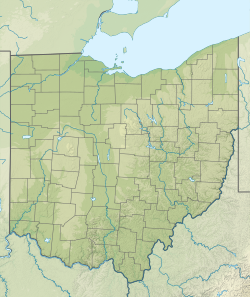History
The airport began as a grand dream on June 22, 1927 with the establishment of The Toledo Airport Committee. $257,000 were raised in early 1928 to fund the airport in 33 1/2 hours, which is the time it took Charles Lindbergh to fly from New York City to Paris. Six hundred and twenty shares of stock were sold to 620 Toledo citizens. [3]
A site was chosen based on proximity to an air route from Chicago to New York, and land was purchased in the spring of 1928. [3] On June 3, 1928, "The Transcontinental Airport of Toledo, Incorporated" was dedicated to a large crowd. The dream was soon realized, as the airport set records for air mail and became the second largest airport east of the Rocky Mountains.
The airport received a complete weather station, and the US Weather Bureau of Toledo operated at the airport until early 1955. [3]
National Air Transport began service with passenger and air mail flights to Chicago and Cleveland, and a national record amount of mail was carried through the airport in 1929. [3]
By 1931, National and three other airlines had merged becoming United Airlines, and Toledo had become a stop on a transcontinental air route extending from San Francisco to New York.
The boom period did not last. Inadequate construction began to crumble, driving away business. The Great Depression hit. However, President Franklin D Roosevelt allocated $216,077 in Works Progress Administration funds for upgrades to the airport in 1936. The city of Toledo provided $52,000 in matching funds. These funds provided three paved runways. [3]
The airport was purchased by the City of Toledo soon after. In 1937, it airport became a Class One port and the second largest airfield east of the Rocky Mountains. [3]
United Airlines paused service in 1938 when the airport's runways began to buckle, leaving the airport unused. Federal grants were provided in 1940 to rebuild the runways, and the airport reopened in 1941. [4] [5]
A terminal building and Air Traffic Control tower were built in 1948. Funds were provided by the City of Toledo and the federal government. [3]
Ultimately, neighboring developments prevented the airport from expanding its runways to meet the needs of increasingly larger commercial aircraft. When the larger Toledo Express Airport was built in 1954, Toledo Executive became redundant, and it was ultimately abandoned. [3]
The field languished for over a decade, used for things such as fireworks displays and drag racing. General Aviation and business jets in the late 1960s and early 1970s brought the field back into use as an airport; private, business and charter flights continue to be the main activities. [3] [4]
In 1966, Executive Aviation signed a fifteen-year lease and invested $250,000 in a new main hangar, 20 T-hangars, and a fuel facility. [3] Astro Aviation took over operations at the airport in 1970, and Crow Executive Air was founded in 1974. [6]
In 1975, the airport was put under the control of the Toledo–Lucas County Port Authority. [3] In 1977, it was renamed in honor of Tommy Metcalf, Toledo's second commissioner of aviation. [7]
In April 2007, a FedEx Boeing 727 landed at the airport to be decommissioned and provided to Owens Community College for ground-based training. [8] The airport's name was changed to Toledo Executive Airport in 2010. [9]
On June 5, 2010, an EF4 tornado passed along the south edge of the airport. Neighboring Lake High School and other structures were severely affected. [10]
Early Nearby Airports
- 215-acre airfield on Stickney Avenue, just north of Toledo. [3]
- Franklin Airport – 5035 Monroe Street in Toledo. It was closed on September 15, 1952. [3]
- National Airport – 165-acre airfield located at Telegraph and Alexis road in Toledo. It was sold in the early 1960s. [3]



